engine YAMAHA WR 250F 2017 Repair Manual
[x] Cancel search | Manufacturer: YAMAHA, Model Year: 2017, Model line: WR 250F, Model: YAMAHA WR 250F 2017Pages: 432, PDF Size: 14.14 MB
Page 131 of 432
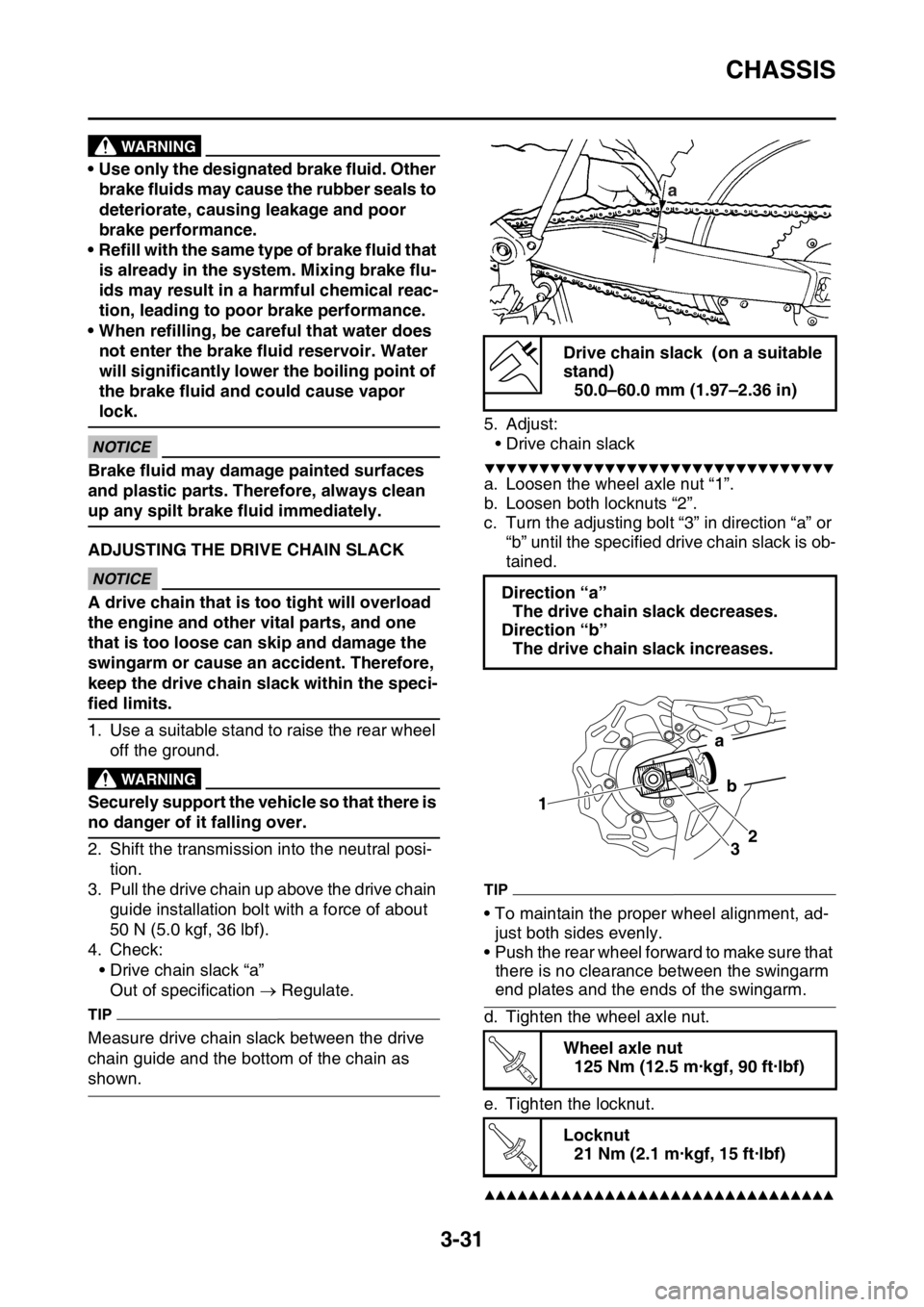
CHASSIS
3-31
EWA
WARNING
• Use only the designated brake fluid. Other
brake fluids may cause the rubber seals to
deteriorate, causing leakage and poor
brake performance.
• Refill with the same type of brake fluid that
is already in the system. Mixing brake flu-
ids may result in a harmful chemical reac-
tion, leading to poor brake performance.
• When refilling, be careful that water does
not enter the brake fluid reservoir. Water
will significantly lower the boiling point of
the brake fluid and could cause vapor
lock.
ECA
NOTICE
Brake fluid may damage painted surfaces
and plastic parts. Therefore, always clean
up any spilt brake fluid immediately.
EAS2GBB110ADJUSTING THE DRIVE CHAIN SLACKECA
NOTICE
A drive chain that is too tight will overload
the engine and other vital parts, and one
that is too loose can skip and damage the
swingarm or cause an accident. Therefore,
keep the drive chain slack within the speci-
fied limits.
1. Use a suitable stand to raise the rear wheel
off the ground.
EWA
WARNING
Securely support the vehicle so that there is
no danger of it falling over.
2. Shift the transmission into the neutral posi-
tion.
3. Pull the drive chain up above the drive chain
guide installation bolt with a force of about
50 N (5.0 kgf, 36 lbf).
4. Check:
• Drive chain slack “a”
Out of specification Regulate.
TIP
Measure drive chain slack between the drive
chain guide and the bottom of the chain as
shown.5. Adjust:
• Drive chain slack
▼▼▼▼▼▼▼▼▼▼▼▼▼▼▼▼▼▼▼▼▼▼▼▼▼▼▼▼▼▼▼▼
a. Loosen the wheel axle nut “1”.
b. Loosen both locknuts “2”.
c. Turn the adjusting bolt “3” in direction “a” or
“b” until the specified drive chain slack is ob-
tained.
TIP
• To maintain the proper wheel alignment, ad-
just both sides evenly.
• Push the rear wheel forward to make sure that
there is no clearance between the swingarm
end plates and the ends of the swingarm.
d. Tighten the wheel axle nut.
e. Tighten the locknut.
▲▲▲▲▲▲▲▲▲▲▲▲▲▲▲▲▲▲▲▲▲▲▲▲▲▲▲▲▲▲▲▲
Drive chain slack (on a suitable
stand)
50.0–60.0 mm (1.97–2.36 in)
Direction “a”
The drive chain slack decreases.
Direction “b”
The drive chain slack increases.
Wheel axle nut
125 Nm (12.5 m·kgf, 90 ft·lbf)
Locknut
21 Nm (2.1 m·kgf, 15 ft·lbf)
a
1
32
a
b
T R..
T R..
Page 138 of 432

CHASSIS
3-38
c. Turn the front fork to the right and left a few
times, and make sure that the steering ro-
tates smoothly. If it does not turn smoothly,
remove the lower bracket and check the up-
per and lower bearings.
Refer to “STEERING HEAD” on page 5-53.
d. Loosen the ring nut fully turn and then tight-
en it to specification with a steering nut
wrench.
EWA
WARNING
Do not overtighten the lower ring nut.
e. Check the steering head for looseness or
binding by turning the front fork all the way in
both directions. If any binding is felt, remove
the lower bracket and check the upper and
lower bearings.
Refer to “STEERING HEAD” on page 5-53.
f. Install the washer “1”.
▲▲▲▲▲▲▲▲▲▲▲▲▲▲▲▲▲▲▲▲▲▲▲▲▲▲▲▲▲▲▲▲
5. Install:
• Upper bracket
Refer to “STEERING HEAD” on page 5-53.
• Handlebar
Refer to “HANDLEBAR” on page 5-33.
EAS2GBB124CHECKING AND LUBRICATING THE CA-
BLES
The following procedure applies to all of the in-
ner and outer cables.
EWA
WARNING
Damaged outer cable may cause the cable
to corrode and interfere with its movement.
Replace damaged outer cable and inner ca-
bles as soon as possible.1. Check:
• Outer cable
Damage Replace.
2. Check:
• Cable operation
Rough movement Lubricate.
TIP
Hold the cable end upright and pour a few
drops of lubricant into the cable sheath or use
a suitable lubricating device.
EAS2GBB125LUBRICATING THE LEVERS
1. Lubricate the pivoting points and metal-to-
metal moving parts of the following parts.
•Brake lever
• Clutch lever
EAS2GBB126LUBRICATING THE PEDAL
1. Lubricate the pivoting point and metal-to-
metal moving parts of the pedal.
EAS2GBB127LUBRICATING THE DRIVE CHAIN
The drive chain consists of many interacting
parts. If the drive chain is not maintained prop-
erly, it will wear out quickly. Therefore, the drive
chain should be serviced, especially when the
vehicle is used in dusty areas.
This vehicle has a drive chain with small rubber
O-rings between each side plate. Steam clean-
ing, high-pressure washing, certain solvents,
and the use of a coarse brush can damage
these O-rings. Therefore, use only kerosene to
clean the drive chain. Wipe the drive chain dry
and thoroughly lubricate it with engine oil or
chain lubricant that is suitable for O-ring chains.
Do not use any other lubricants on the drive
chain since they may contain solvents that
could damage the O-rings. Ring nut (initial tightening torque)
38 Nm (3.8 m·kgf, 27 ft·lbf)
Ring nut (final tightening torque)
7 Nm (0.7 m·kgf, 5.1 ft·lbf)
T R..
T R..
1
Recommended lubricant
Engine oil or a suitable cable lu-
bricant
Recommended lubricant
Silicone grease
Recommended lubricant
Lithium-soap-based grease
Recommended lubricant
Lithium-soap-based grease
Page 141 of 432
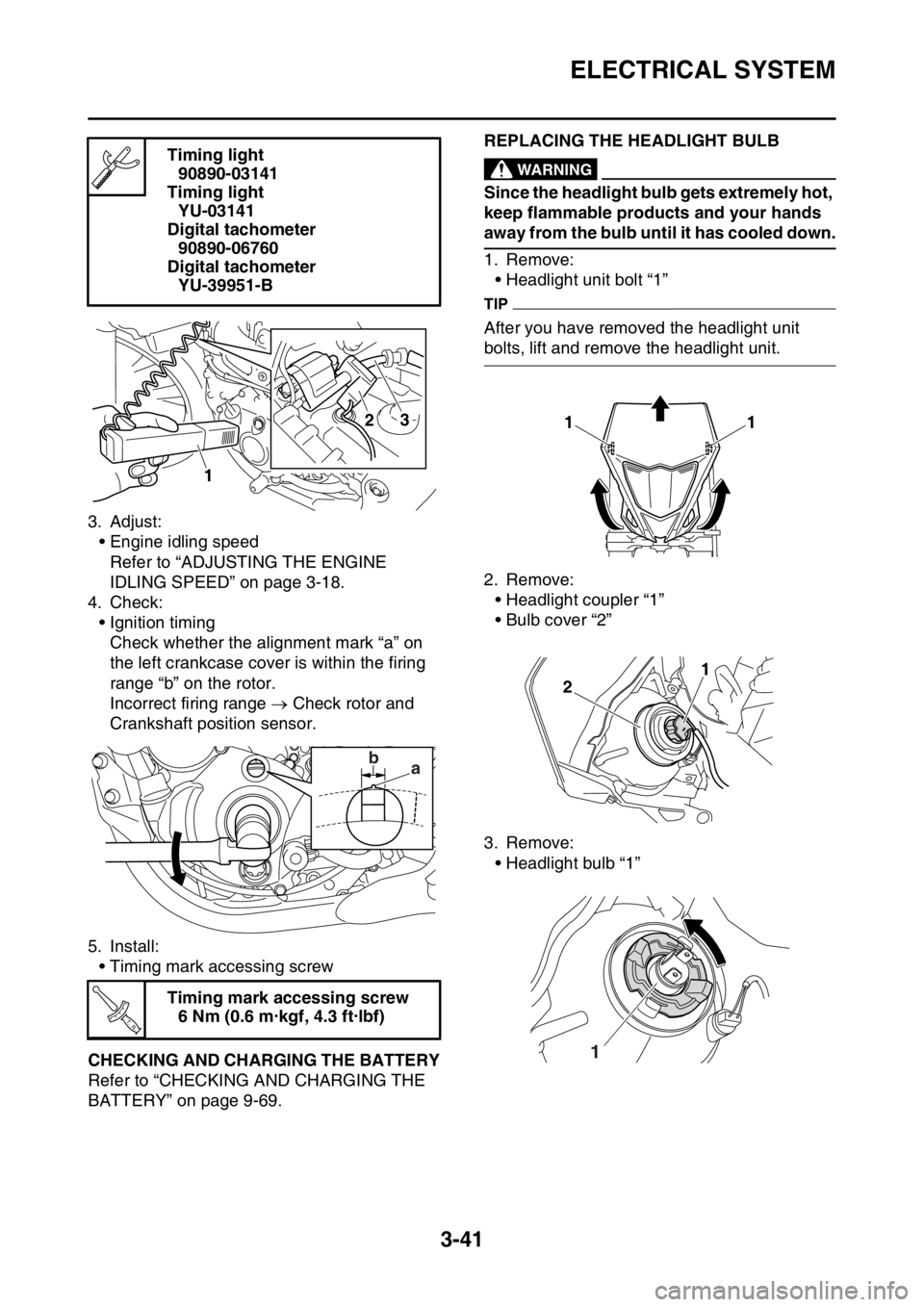
ELECTRICAL SYSTEM
3-41
3. Adjust:
• Engine idling speed
Refer to “ADJUSTING THE ENGINE
IDLING SPEED” on page 3-18.
4. Check:
• Ignition timing
Check whether the alignment mark “a” on
the left crankcase cover is within the firing
range “b” on the rotor.
Incorrect firing range Check rotor and
Crankshaft position sensor.
5. Install:
• Timing mark accessing screw
EAS2GBB133CHECKING AND CHARGING THE BATTERY
Refer to “CHECKING AND CHARGING THE
BATTERY” on page 9-69.
EAS2GBB134REPLACING THE HEADLIGHT BULBEWA
WARNING
Since the headlight bulb gets extremely hot,
keep flammable products and your hands
away from the bulb until it has cooled down.
1. Remove:
• Headlight unit bolt “1”
TIP
After you have removed the headlight unit
bolts, lift and remove the headlight unit.
2. Remove:
• Headlight coupler “1”
• Bulb cover “2”
3. Remove:
• Headlight bulb “1” Timing light
90890-03141
Timing light
YU-03141
Digital tachometer
90890-06760
Digital tachometer
YU-39951-B
Timing mark accessing screw
6 Nm (0.6 m·kgf, 4.3 ft·lbf)
2
1
3
ba
T R..
11
1
2
1
Page 146 of 432
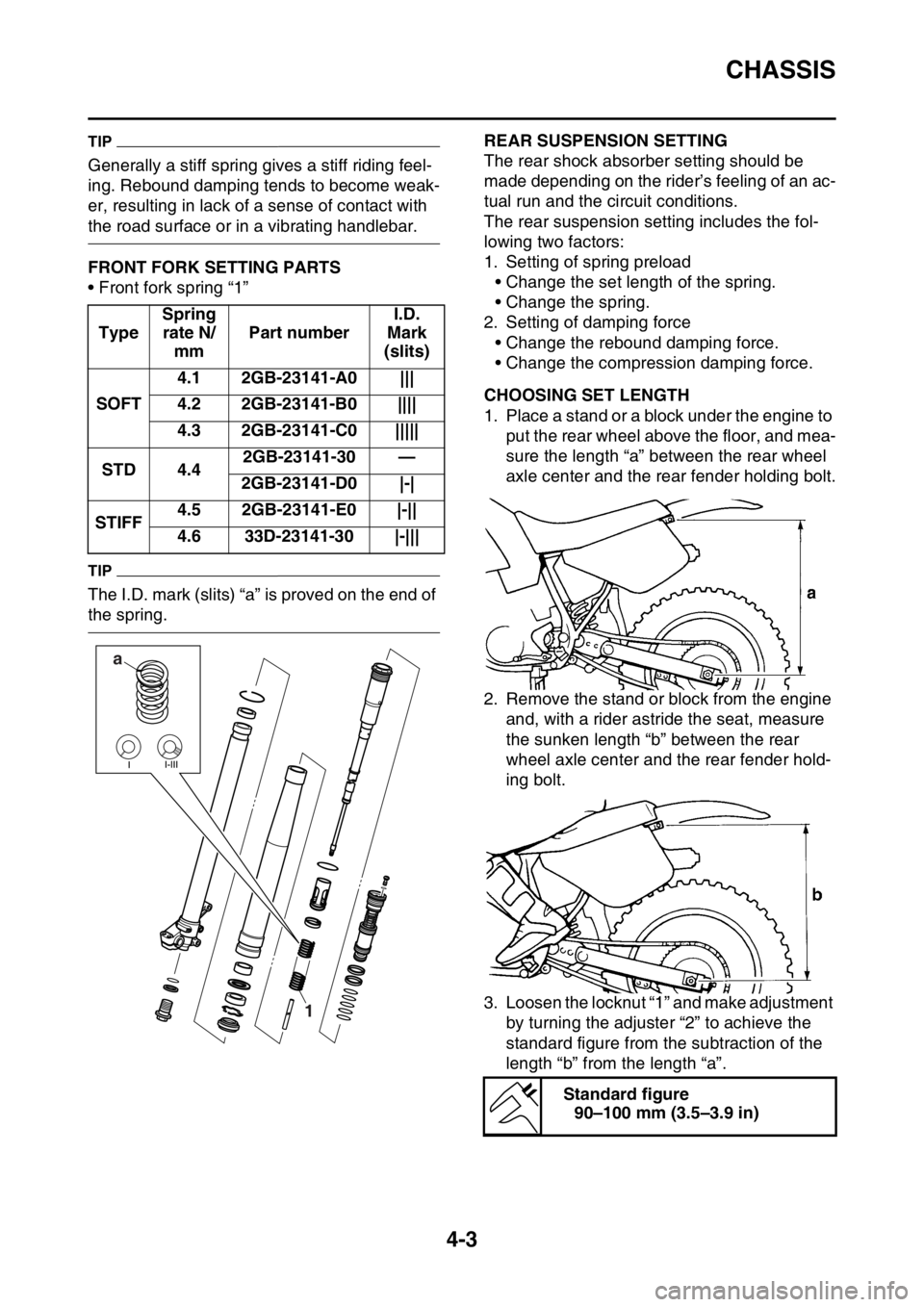
CHASSIS
4-3
TIP
Generally a stiff spring gives a stiff riding feel-
ing. Rebound damping tends to become weak-
er, resulting in lack of a sense of contact with
the road surface or in a vibrating handlebar.
EAS2GBB143FRONT FORK SETTING PARTS
• Front fork spring “1”
TIP
The I.D. mark (slits) “a” is proved on the end of
the spring.
EAS2GBB144REAR SUSPENSION SETTING
The rear shock absorber setting should be
made depending on the rider’s feeling of an ac-
tual run and the circuit conditions.
The rear suspension setting includes the fol-
lowing two factors:
1. Setting of spring preload
• Change the set length of the spring.
• Change the spring.
2. Setting of damping force
• Change the rebound damping force.
• Change the compression damping force.
EAS2GBB145CHOOSING SET LENGTH
1. Place a stand or a block under the engine to
put the rear wheel above the floor, and mea-
sure the length “a” between the rear wheel
axle center and the rear fender holding bolt.
2. Remove the stand or block from the engine
and, with a rider astride the seat, measure
the sunken length “b” between the rear
wheel axle center and the rear fender hold-
ing bolt.
3. Loosen the locknut “1” and make adjustment
by turning the adjuster “2” to achieve the
standard figure from the subtraction of the
length “b” from the length “a”. TypeSpring
rate N/
mmPart numberI.D.
Mark
(slits)
SOFT4.1 2GB-23141-A0 |||
4.2 2GB-23141-B0 ||||
4.3 2GB-23141-C0 |||||
STD 4.42GB-23141-30 —
2GB-23141-D0 |-|
STIFF4.5 2GB-23141-E0 |-||
4.6 33D-23141-30 |-|||
a
1
Standard figure
90–100 mm (3.5–3.9 in)
Page 155 of 432
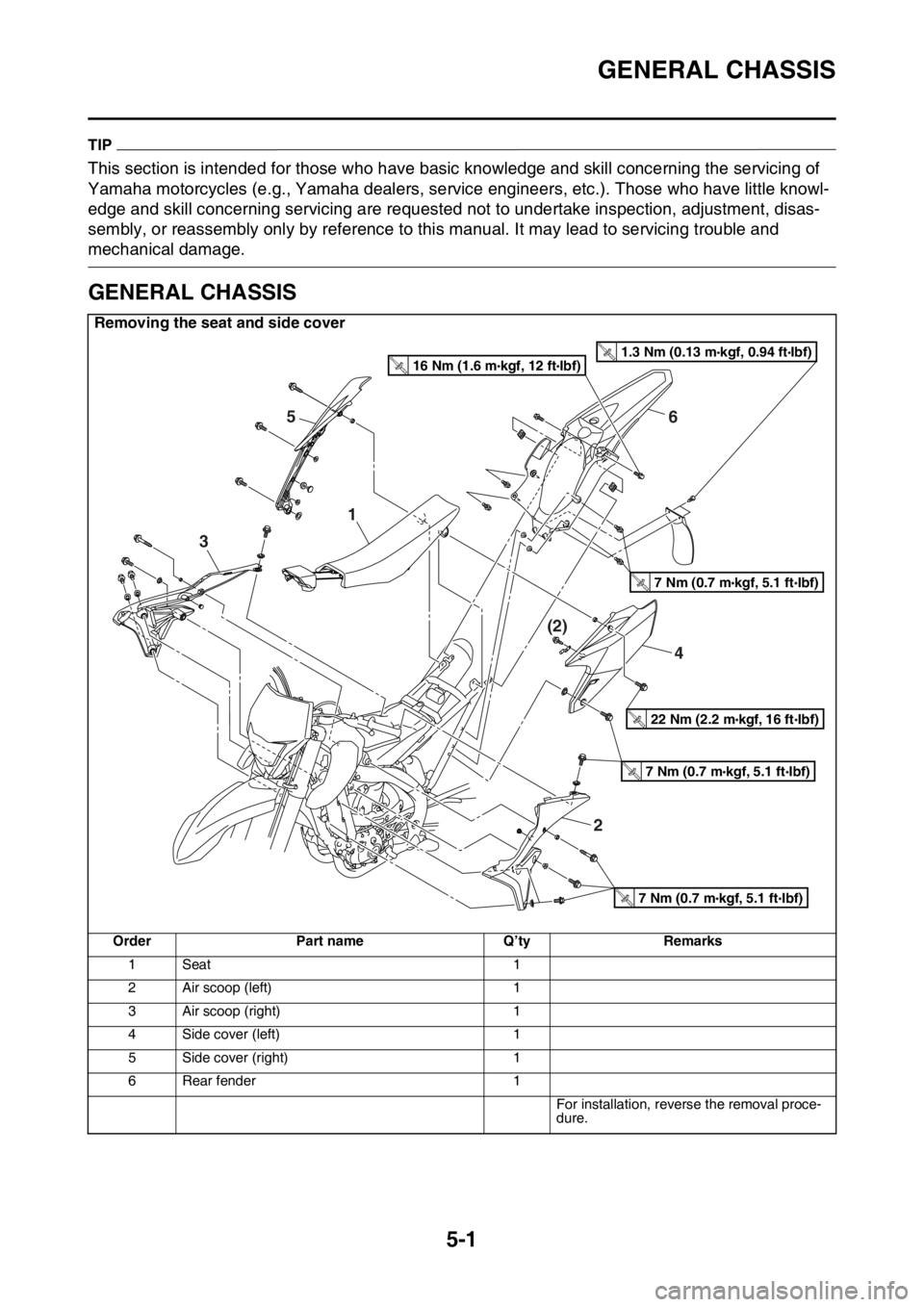
GENERAL CHASSIS
5-1
EAS2GBB150
TIP
This section is intended for those who have basic knowledge and skill concerning the servicing of
Yamaha motorcycles (e.g., Yamaha dealers, service engineers, etc.). Those who have little knowl-
edge and skill concerning servicing are requested not to undertake inspection, adjustment, disas-
sembly, or reassembly only by reference to this manual. It may lead to servicing trouble and
mechanical damage.
EAS2GBB151
GENERAL CHASSIS
Removing the seat and side cover
Order Part name Q’ty Remarks
1 Seat 1
2 Air scoop (left) 1
3 Air scoop (right) 1
4 Side cover (left) 1
5 Side cover (right) 1
6 Rear fender 1
For installation, reverse the removal proce-
dure.
4 (2)
65
1
3
2
7 Nm (0.7 m kgf, 5.1 ft Ibf)T.R.
7 Nm (0.7 m kgf, 5.1 ft Ibf)T.R.
7 Nm (0.7 m kgf, 5.1 ft Ibf)T.R.
22 Nm (2.2 m kgf, 16 ft Ibf)T.R.
1.3 Nm (0.13 m kgf, 0.94 ft Ibf)T.R.16 Nm (1.6 m kgf, 12 ft Ibf)T.R.
Page 187 of 432
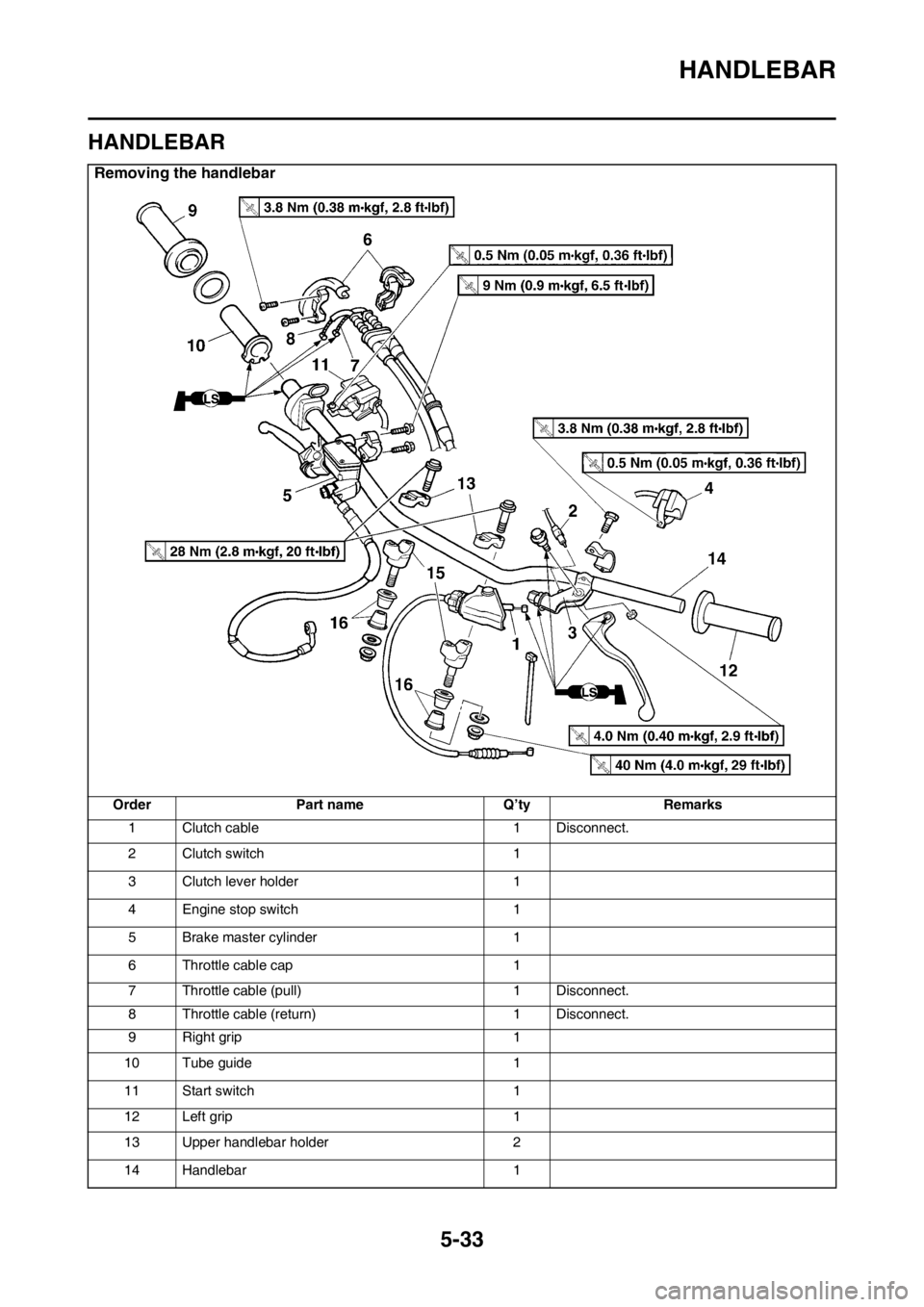
HANDLEBAR
5-33
EAS2GBB193
HANDLEBAR
Removing the handlebar
Order Part name Q’ty Remarks
1 Clutch cable 1 Disconnect.
2 Clutch switch 1
3 Clutch lever holder 1
4 Engine stop switch 1
5 Brake master cylinder 1
6 Throttle cable cap 1
7 Throttle cable (pull) 1 Disconnect.
8 Throttle cable (return) 1 Disconnect.
9 Right grip 1
10 Tube guide 1
11 Start switch 1
12 Left grip 1
13 Upper handlebar holder 2
14 Handlebar 1
Page 191 of 432
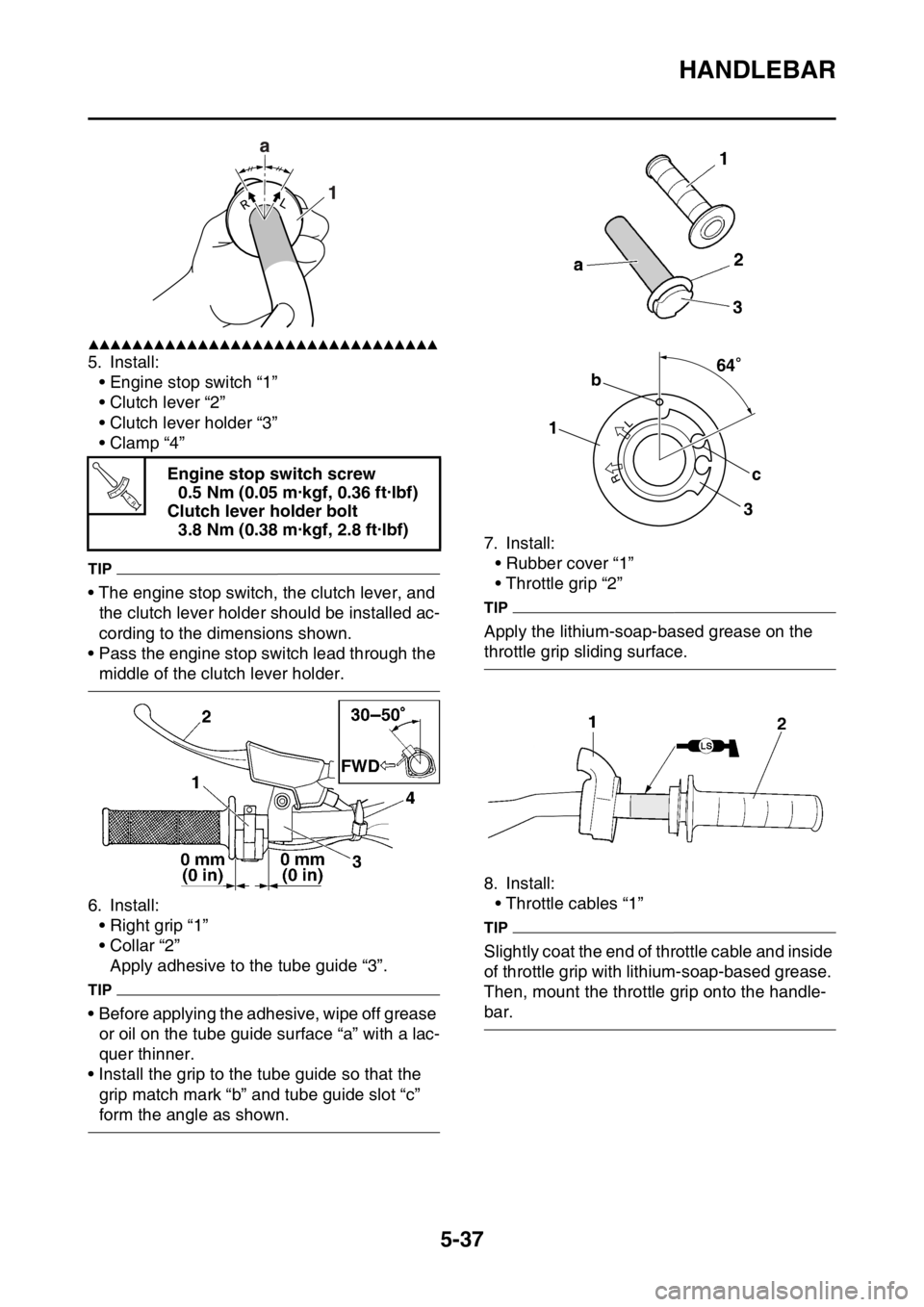
HANDLEBAR
5-37
▲▲▲▲▲▲▲▲▲▲▲▲▲▲▲▲▲▲▲▲▲▲▲▲▲▲▲▲▲▲▲▲
5. Install:
• Engine stop switch “1”
• Clutch lever “2”
• Clutch lever holder “3”
•Clamp “4”
TIP
• The engine stop switch, the clutch lever, and
the clutch lever holder should be installed ac-
cording to the dimensions shown.
• Pass the engine stop switch lead through the
middle of the clutch lever holder.
6. Install:
• Right grip “1”
• Collar “2”
Apply adhesive to the tube guide “3”.
TIP
• Before applying the adhesive, wipe off grease
or oil on the tube guide surface “a” with a lac-
quer thinner.
• Install the grip to the tube guide so that the
grip match mark “b” and tube guide slot “c”
form the angle as shown.7. Install:
• Rubber cover “1”
• Throttle grip “2”
TIP
Apply the lithium-soap-based grease on the
throttle grip sliding surface.
8. Install:
• Throttle cables “1”
TIP
Slightly coat the end of throttle cable and inside
of throttle grip with lithium-soap-based grease.
Then, mount the throttle grip onto the handle-
bar. Engine stop switch screw
0.5 Nm (0.05 m·kgf, 0.36 ft·lbf)
Clutch lever holder bolt
3.8 Nm (0.38 m·kgf, 2.8 ft·lbf)
T R..
64
1b
c
3 64
Page 222 of 432
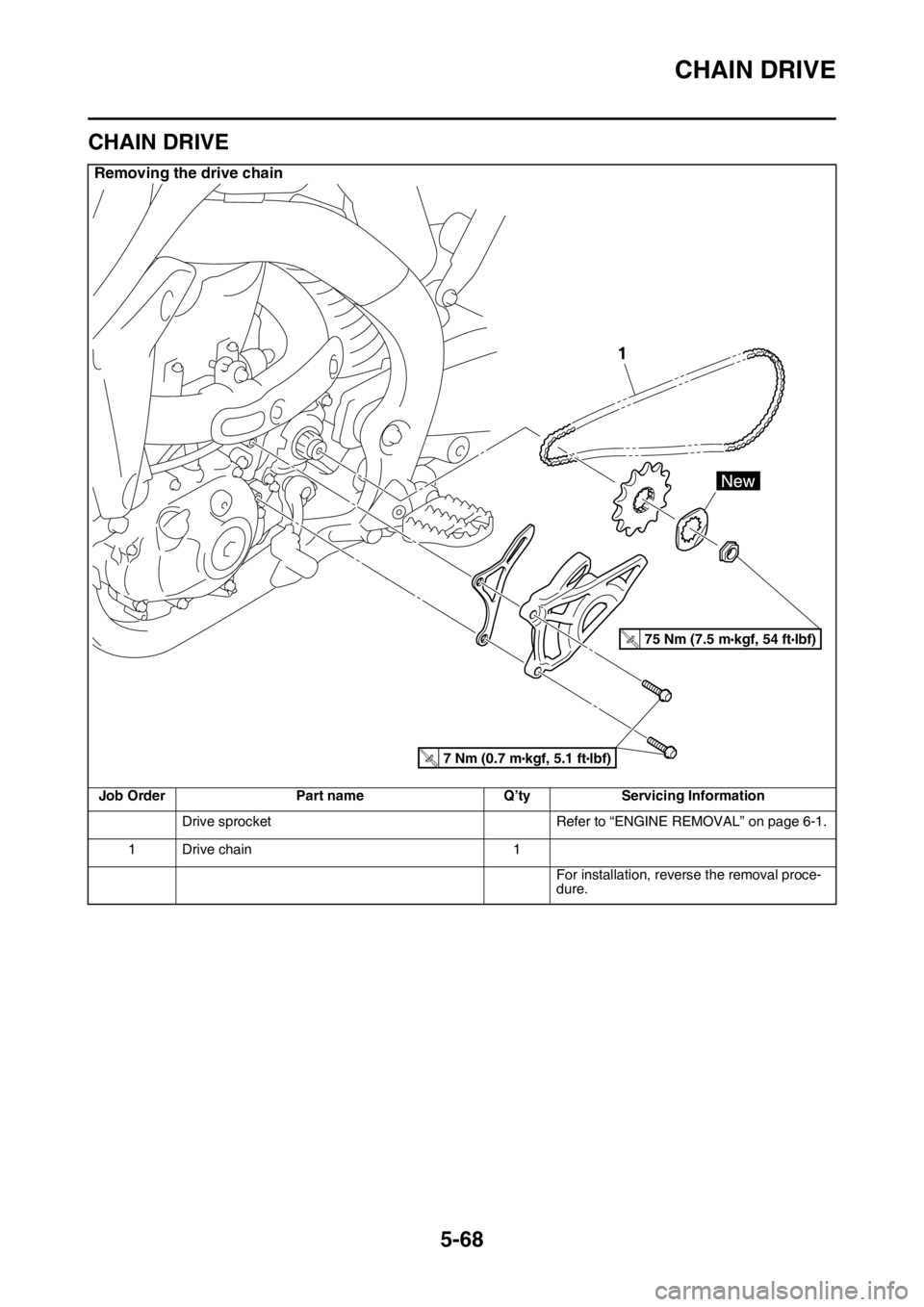
CHAIN DRIVE
5-68
EAS2GBB221
CHAIN DRIVE
Removing the drive chain
Job Order Part name Q’ty Servicing Information
Drive sprocket Refer to “ENGINE REMOVAL” on page 6-1.
1 Drive chain 1
For installation, reverse the removal proce-
dure.
1
T.R.75 Nm (7.5 mlbf) kgf, 54 ft
T.R.7 Nm (0.7 mlbf) kgf, 5.1 ft
Page 225 of 432
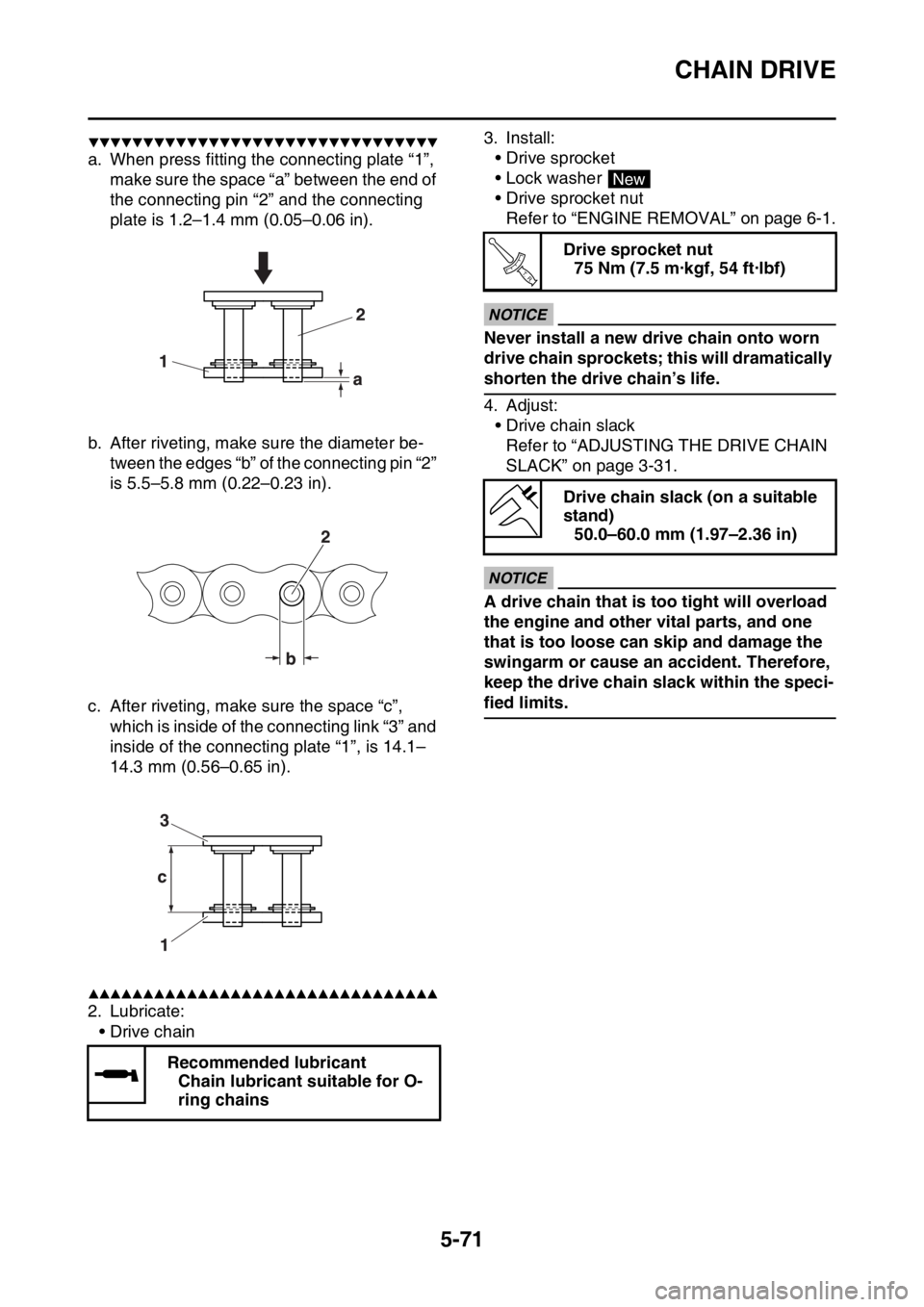
CHAIN DRIVE
5-71
▼▼▼▼▼▼▼▼▼▼▼▼▼▼▼▼▼▼▼▼▼▼▼▼▼▼▼▼▼▼▼▼
a. When press fitting the connecting plate “1”,
make sure the space “a” between the end of
the connecting pin “2” and the connecting
plate is 1.2–1.4 mm (0.05–0.06 in).
b. After riveting, make sure the diameter be-
tween the edges “b” of the connecting pin “2”
is 5.5–5.8 mm (0.22–0.23 in).
c. After riveting, make sure the space “c”,
which is inside of the connecting link “3” and
inside of the connecting plate “1”, is 14.1–
14.3 mm (0.56–0.65 in).
▲▲▲▲▲▲▲▲▲▲▲▲▲▲▲▲▲▲▲▲▲▲▲▲▲▲▲▲▲▲▲▲
2. Lubricate:
•Drive chain3. Install:
• Drive sprocket
• Lock washer
• Drive sprocket nut
Refer to “ENGINE REMOVAL” on page 6-1.
ECA
NOTICE
Never install a new drive chain onto worn
drive chain sprockets; this will dramatically
shorten the drive chain’s life.
4. Adjust:
• Drive chain slack
Refer to “ADJUSTING THE DRIVE CHAIN
SLACK” on page 3-31.
ECA
NOTICE
A drive chain that is too tight will overload
the engine and other vital parts, and one
that is too loose can skip and damage the
swingarm or cause an accident. Therefore,
keep the drive chain slack within the speci-
fied limits.
Recommended lubricant
Chain lubricant suitable for O-
ring chains
Drive sprocket nut
75 Nm (7.5 m·kgf, 54 ft·lbf)
Drive chain slack (on a suitable
stand)
50.0–60.0 mm (1.97–2.36 in)
New
T R..
Page 227 of 432
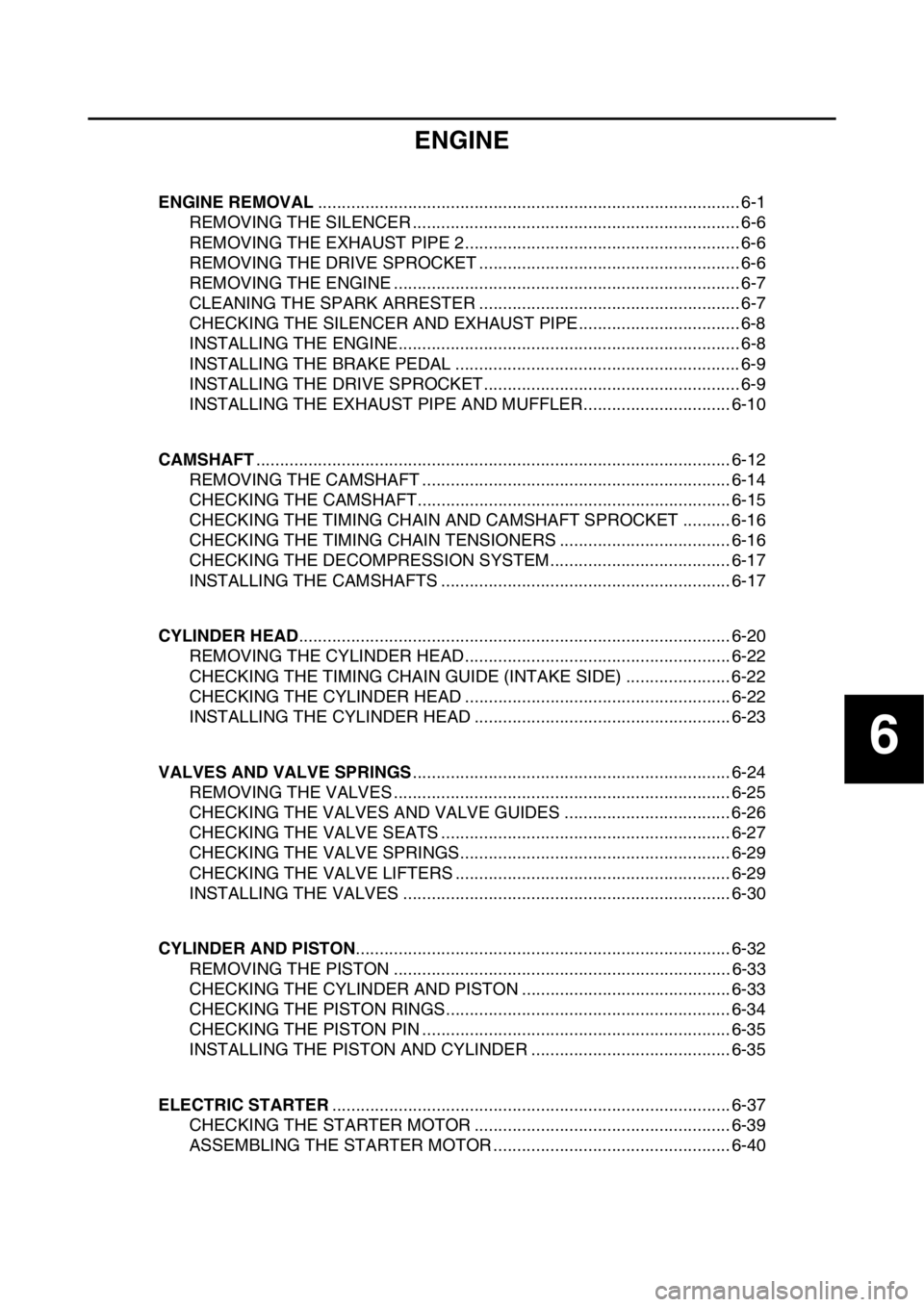
6
ENGINE
ENGINE REMOVAL......................................................................................... 6-1
REMOVING THE SILENCER ..................................................................... 6-6
REMOVING THE EXHAUST PIPE 2.......................................................... 6-6
REMOVING THE DRIVE SPROCKET ....................................................... 6-6
REMOVING THE ENGINE ......................................................................... 6-7
CLEANING THE SPARK ARRESTER ....................................................... 6-7
CHECKING THE SILENCER AND EXHAUST PIPE.................................. 6-8
INSTALLING THE ENGINE........................................................................ 6-8
INSTALLING THE BRAKE PEDAL ............................................................ 6-9
INSTALLING THE DRIVE SPROCKET...................................................... 6-9
INSTALLING THE EXHAUST PIPE AND MUFFLER............................... 6-10
CAMSHAFT.................................................................................................... 6-12
REMOVING THE CAMSHAFT ................................................................. 6-14
CHECKING THE CAMSHAFT.................................................................. 6-15
CHECKING THE TIMING CHAIN AND CAMSHAFT SPROCKET .......... 6-16
CHECKING THE TIMING CHAIN TENSIONERS .................................... 6-16
CHECKING THE DECOMPRESSION SYSTEM...................................... 6-17
INSTALLING THE CAMSHAFTS ............................................................. 6-17
CYLINDER HEAD........................................................................................... 6-20
REMOVING THE CYLINDER HEAD........................................................ 6-22
CHECKING THE TIMING CHAIN GUIDE (INTAKE SIDE) ...................... 6-22
CHECKING THE CYLINDER HEAD ........................................................ 6-22
INSTALLING THE CYLINDER HEAD ...................................................... 6-23
VALVES AND VALVE SPRINGS................................................................... 6-24
REMOVING THE VALVES ....................................................................... 6-25
CHECKING THE VALVES AND VALVE GUIDES ................................... 6-26
CHECKING THE VALVE SEATS ............................................................. 6-27
CHECKING THE VALVE SPRINGS......................................................... 6-29
CHECKING THE VALVE LIFTERS .......................................................... 6-29
INSTALLING THE VALVES ..................................................................... 6-30
CYLINDER AND PISTON............................................................................... 6-32
REMOVING THE PISTON ....................................................................... 6-33
CHECKING THE CYLINDER AND PISTON ............................................ 6-33
CHECKING THE PISTON RINGS............................................................ 6-34
CHECKING THE PISTON PIN ................................................................. 6-35
INSTALLING THE PISTON AND CYLINDER .......................................... 6-35
ELECTRIC STARTER.................................................................................... 6-37
CHECKING THE STARTER MOTOR ...................................................... 6-39
ASSEMBLING THE STARTER MOTOR .................................................. 6-40